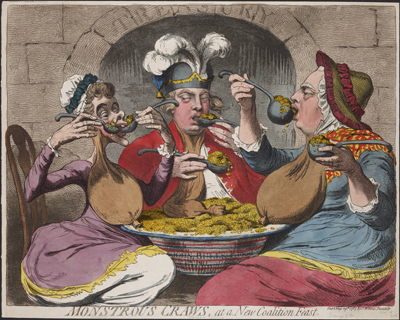Monstrous Craws at a New Coalition Feast
Part of Gillray's job as a satirist was to find striking and accessible images for contemporary political events. He had already used the Bible (Ahithophel in the Dumps), classical mythology (Jove in his Chair), Roman history (Cincinnatus in Retirement) and popular English mythology St. George and the Dragon as sources for these images. But now he also began to use random current events that happened to have made the news and would presumably provide an immediately understandable analogue for his subject. Monstrous Craws is a perfect example.
In the Morning Chronicle and London Advertiser for May 21st, 1787, eight days before Gillray's print appeared, the public was informed of the arrival of the "Royal Circus" including "the famous monkey, General Jackoo; several extraordinary manoeuvres by the Dancing Dogs, the surprising Learned Pig. . . [and] a troop of Female Rope Dancers." But the Chronicle went on to say that
the famous exhibition of the three Wonderful MONSTROUS CRAWS, wild human Beings, in the Hay Market [can] at once justly assume to itself the title or epithet of 'ne plus ultra' over all other exhibitions extant, past or to come; and this for reason of its affording amazing pleasure, satisfaction, and entertainment to all the beholders of it, whether males or females, children, youth, or grown up people."

© Lewis Walpole Library, Yale University
The advertisement, with MONSTROUS CRAWS in all caps, gave Gillray the perfect image to reinforce the charge he had made in A New Way to Pay the National Debt in March 1786: that the King and Queen were ravenous in their appetite for consuming the national wealth, identified here as "John Bull's Blood."
Like the earlier print, Monstrous Craws is situated at the mouth of the Treasury. A contemporary handbill advertising the three Monstrous Craws at the Hay Market shows two women on either side of a man. So Gillray borrows that additional detail, portraying both Queen Charlotte and King George as women with craws resembling huge pendulous breasts as they ladle in the coins from the bowl before them.
Between them is the Prince of Wales whose crown is also a fools cap. His craw is almost empty compared to those of his parents, but he is now using both spoon and ladle (labeled £10,000 and £60,000 per annum respectively) to catch up to his parents. This probably refers to the agreement reached on May 21st to settle the Prince's debts and increase his income. The Prince's new annual allowance which was raised from £50,000 to £60,000 per annum, in addition to approximately £10,000 per annum revenue from the Duchy of Cornwall presented by his father. The print does not mention the £161,000 to pay off the Prince's existing debts or the £53,000 allocated to cover expenditures already made for the construction of Carleton House. But the Prince seems to be less than satisfied with his share since he is looking askance towards his mother as if he would have her portion too.
In fact, this "feast" provided by a tense negotiation between Whigs and Tories, Pitt and the Prince proved all too lttle. By 1795, he was once again dependent upon Parliament to pay his new debts.
Sources and Reading
- Commentary from the British Museum on Monstrous Craws at a New Coalition Feast
- Draper Hill, Fashionable Contrasts, 1966 #53
- Draper Hill, The Satirical Etchings of James Gillray, 1976 #10
- "George IV of the United Kingdom," Wikipedia
- Thomas Wright and R.H. Evans, Historical and Descriptive Account of the Caricatures of James Gillray #24
Comments & Corrections
NOTE: Comments and/or corrections are always appreciated. To make that easier, I have included a form below that you can use. I promise never to share any of the info provided without your express permission.